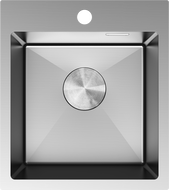
A thermostatic valve, also known as a thermostatic head, is a device used to regulate the flow of hot water through a radiator, allowing control of the temperature in a room.
It is a component of a heating system that automatically reacts to decreases or increases in ambient temperature.
How does a thermostatic head work? Below you will find some key information about its operation and the benefits of using these devices.
How does a thermostat work in a radiator?
A thermostatic head contains a sensitive element with high thermal expansion that increases in volume or shrinks in response to changes in ambient temperature. The most commonly used materials in this element are:
- Bimetal - a plate made of two different metals that expand at different rates when heated. A change in temperature causes the bimetal to bend, which can directly open or close an electrical circuit or act on a switching mechanism.
- Expanding substances - in some radiator valves, a liquid that expands with rising temperature is used. During expansion, the substance moves a piston that regulates the flow of water through the radiator.
Switch / Mechanism responsible for temperature regulation
Once a certain temperature is reached, the aforementioned sensitive element activates a switch or another mechanism that opens or closes an electrical circuit. In heating systems, this helps control the operation of heat pumps, gas or electric boilers by turning heating on or off depending on the set temperature.
User settings
The thermostat allows the user to set the desired temperature. When the room temperature reaches the level set on the thermostat, the switching mechanism turns off the heating to maintain thermal comfort without unnecessary energy consumption.
Return to normal operation
When the room temperature drops below the set value, the sensitive element reacts and reactivates the heating system to maintain warmth at a constant level.
Why should you install a thermostatic head? Benefits of using a thermostatic head
Electronic thermostatic heads carry a number of benefits in terms of both economic and practical aspects. Their use significantly improves living comfort, energy efficiency, and environmental protection. Here are some of the main benefits resulting from the use of thermostatic heads.
1. Energy savings
One of the main advantages of thermostatic heads is the significant reduction in energy consumption. Thanks to the ability to precisely set the temperature in individual rooms (in newer models, remote control via a mobile app is possible), the heating system operates only when necessary, minimizing unnecessary heat loss and reducing heating costs. Users can adjust the temperature and lower it, for example, in less frequently used living spaces, which further contributes to reducing overall energy consumption.
2. User comfort
Thermostatic heads enable automatic temperature regulation, ensuring a constant and even heat level in rooms. Users can adjust the settings according to their preferences, increasing comfort and allowing the maintenance of optimal temperature without the need for continuous adjustment.
3. Reduction in carbon dioxide emissions
By optimizing energy consumption, thermostatic heads contribute to reducing CO2 emissions into the atmosphere. This is especially important in the context of global efforts for environmental protection and combating climate change.
4. Ease of installation and operation
Thermostatic heads are generally easy to install. Their operation is intuitive, making them accessible to users with varying levels of technical expertise.
5. Heating control
Thermostatic heads allow for individual temperature control in different rooms, which is particularly useful in multi-room buildings. This enables better energy management and adjustment of heating to the specific needs of users.
How does a thermostatic head work in a radiator - summary
The thermostatic head in a radiator is a key element of a heating system that guarantees not only comfort and convenience of use but also contributes to significant energy savings and reduction of negative environmental impact.
It works by responding to changes in room temperature, automatically regulating the flow of hot water through the radiator. Thanks to the temperature-sensitive element, the thermostatic head can control the operation of the radiator, adjusting its efficiency to current needs.
The practicality of thermostatic heads is evident not only in their functionality but also in their extremely easy installation.
Investing in high-quality thermostatic heads quickly pays off through reduced heating costs and increased energy efficiency of the entire building.


















